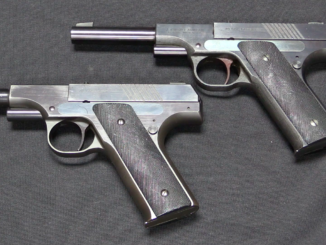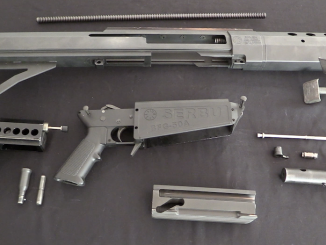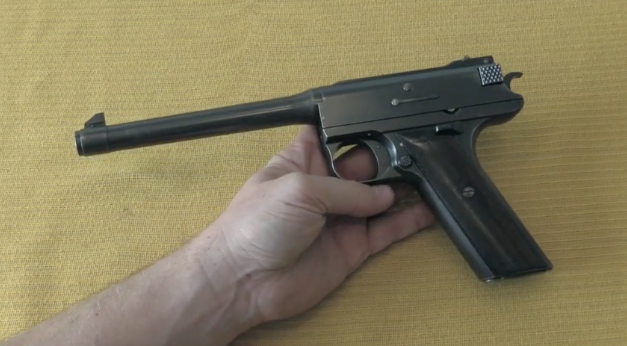This really isn’t a book, but rather an article published for the Kindle. Malcolm Werner is a long-time skilled IPSC competitor and professional engineer, and decided to look at why the Colt 1911 was designed the way it was, and how that has allowed it to remain so popular for more than a century. The article is 97 pages long (with pretty large text), and half of that length is the text of the Thompson/LaGarde ammunition testing included as an appendix.
Werner’s article basically looks at the original Army requirements for its first self-loading pistol and compares the 1911, Glock, and Beretta 92 through the lens of those criteria. He then addresses some of the shortcomings and perceived shortcomings of the 1911 design, and explains them in terms of the materials and manufacturing technology of the period when the pistol was designed. For example, the lowered ejection port that acts to improve ejection reliability on modern 1911s removes material from the slide, and would have probably led to cracked slides if implemented with 1911-era gun steels.
I found the Army requirement analysis fairly self-evident, but the modern engineering look at the original 1911 features was interesting. The whole piece is pretty brief, and will definitely leave engineering-oriented folks feeling like it’s just an introduction to the subject – but to the moderately interested 1911 enthusiast I think it will provide some pretty neat perspective on a pretty cool gun. The full text of the Thompson/LaGarde testing in the final appendix makes for macabre but interesting reading, as it compared the effect of .38, 7.65mm, 9mm, .45, .455, and .476 caliber cartridges on large mammals (cattle, mostly). Of course, this text is also available elsewhere (at the Unblinking Eye, for example), so that may not be a reason to pay for Werner’s Kindle article.
The price is $1.95, and I don’t feel cheated for having spent it, although I think the subject would be much better addressed in a longer and more thorough volume, for a greater price. If you got an Amazon gift card for Christmas yesterday, this is a fine way to use up the last few bucks…




All these mentioned pistols or better say design directions have problem of their own. On all tilt barrel pistols (maybe with exception of HK), like it of not, barrel is poorly guided in front which takes away from accuracy.
On the other hand, the design which should have been at better start point such as P39/M92 have significantly weakened slide. If anything new should come up it should bypass all these mainstream designs with brand new conception.
“barrel is poorly guided(…)weakened slide”
Why gas-operated pistols are so unpopular? Are they very expensive to produce?
Fixed barrel should give good accuracy.
The only mass-produced gas-operated I know is Wildey Magnum hunting pistol.
On the other hand – some European armies used blow-back for many years – for examples Sweden used Husqvarna m/1907 pistols, Soviet Union used Makarov pistols.
“The only mass-produced gas-operated I know is Wildey Magnum hunting pistol.”
There’s the Desert Eagle that is/was made in far larger numbers than the Wildey.
And many gas delayed blowback guns, such as the Steyr GB, HK P7 series (P7M8, P7M13) & Vektor СР1.
The Desert Eagle is a genuine gas operated pistol. The Steyer GB and HK P7 were sort of gas operated.
Probably soldiers are not looking for one more part (a carbon encrusted piston) to scrub. Leaving special operations out of it, historically it was radio men, tank drivers, pilots, etc., who were issued pistols as a back up. If issued to front line troops it was for very close range shooting when rifles were impractical (in a trench, or much latter, in a tunnel, for example). Any tilting barrel design was likely to be more accurate than they needed or were capable of, given the training available to them.
Makarov’s use something close to 380ACP and that is about the limit for blow backs, unless you’re willing to go with a massive slide like a High Point.
“Any tilting barrel design was likely to be more accurate than they needed or were capable of, given the training available to them.”
I agree with you. The thing is that once you look at complex machining of barrel bushing and yet (you cannot avoid it) you end up with a wiggle, you ask yourself: what I am doing? In contrary, on rifle such sloppiness would be unacceptable. Why is it ok on handgun? Because we are used to it. I amused myself in past with ideas with moving chamber behind wrist (of holding hand) but the problem is with magazine; that is unless I want it to be horizontal. There is hardly any way out of this and therefore what we are used to is accepted as a reasonable compromise.
Non corrosive priming didn’t arrive until at least a decade after the 1911 was adopted for service (Herz American patent for lead styphnate priming (1,443,328) was filed November 1919, subsequent patents covered the sensitization of styphnate with tetracene, see Frost for discussion http://www.amazon.co.uk/Ammunition-making-An-insiders-story/dp/0935998578/ref=sr_1_1?ie=UTF8&qid=1388185057&sr=8-1&keywords=frost+ammunition ).
The maintenance of a gas port in the bore and gas piston and cylinder, during the period of corrosive priming would have presented major problems in the field.
In any event, Browning’s combination of the breech bolt and slide into a single unit, allows sufficeint momentum to be retained for reliable operation, at lower bolt speeds than designs such as the Federle Mauser C96 or Lahti’s L35,
That slower bolt movement allows more time for the magazine follower to raise the next round into position to feed reliably.
The combined slide / breech bolt also avoids the need for an accelerator to transfer momentum from the slide to the lighter bolt and buffer the slide on unlocking, examples of the accelerator would be Schwarzlose’ 1890s rotating bolt pistols, the Borchardt and Luger toggle lock pistols, Lahti – of course, and the 1970s reincarnation of the Schwarzlose – the automag.
We readers at FW have that glorious opportunity like hardly anyone else – have (courtesy of editor) almost complete review of what was done in past.
No need to assume automatically ‘gas operated’. There is quite well worked out rotary locked gun, as Beretta attempted to bring it into the market in order to replace M92; albeit with no success. Rotaries are all known to be very accurate. This may be testimony that M92 for its intents and purposes is still satisfactory, even with its clumsiness (have you handled that gun?).
Now, I have no intent in bragging but since we are that far, I have my own conception I toy with. It is a tilt link arranged such way that instead of operating bellow the barrel it rests on top end locks into usual ejection port. It does not weaken slide in any appreciable way.
Hi, Denny :
Good to hear from you and to read your perceptive comments, as always. This design that you are contemplating — will you be trying to build a working prototype or pre-prototype for proof of concept purposes? It is technically a very interesting idea with potential that may deserve support from more than just the lot of us on the FW web site. Of course, we know that virtually everyone on FW is aware that new concepts and designs in firearms are dependent on many factors working properly together ( metallurgy, engineering design and dimensioning, machining tolerances, timing, ergonomics, etc., etc. ), but one still has to start somewhere.
Good to hear from you Earl
I have basically design completed and in fact attempted marketing it with 2 makers (one in States and one in EU). However as you say, the main thing is – it is physically unproven design. There are two major obstacles here: one is legal point (no-no in this country) but I realize it is not necessarily a ‘gun’ I need to build. As a matter of fact the solid model gives me chance potentially to make a composite model for concerned bits only. (Of course you can say that if kinematics work on solid model, they will likely work as well on real thing.)
The other part (when and if it comes to metal) is prototyping cost. I wish I was able to spent some +20k for that. My next plan is to tackle some smaller firms who might be interested; this is in the U.S., to be clear. But even those must have appropriate licenses which as I understand is getting tougher to have by year if not month.
Having said all this, this is one particular design only; there is potentially lot more to work on IF interested party would emerge.
Denny,
With all due respect, if the tilt barrel design is accuracy compromised as you say why does the pistol dominate in every form of competition for which it is eligible? Here in America it is either the single or double-column variant of the 1911. Elsewhere CZ75-based pistols tend to dominate. Both are, of course, tilt barrel designs. Furthermore, if what you say is true, why would Special Operations units like US Army Delta, SEALs, British SAS, and comparable units universally use tilt barrel pistols? Finally, can you name a single Head of State security detail that uses anything other than a tilt barrel design? Here in the U.S. it’s the Sig 229. Can you imagine any armed group requiring more immediate pinpoint accuracy than those charged with protecting the President?
If your comments are based solely on academic arguments, that’s fine. Such discussions are interesting. But real world end users having the choice of virtually any pistol made choose tilt barrel designs exponentially more often than other variations of the self-loading pistol. Everything is or soon will be a forgotten weapon.
My apologies for all the bold type. I was attempting to emphasize “any” in the final sentence of the first paragraph. Must have forgotten to use the correct closing HTML.
Sorry Bill, I am getting to respond with some delay; just did not follow up after some 3days.
As I can see you are a practical man and you are right in your way. My considerations are stemming out of many years od observations as well as trade experience. I see everything in human endeavour as a compromise. Nothing human made is ‘absolute and perfect’, including firearms design and engineering. Yes, we are getting pretty close in some areas. At the same time, the views are and MUST be of competing nature to advance the state of progress. In conclusion this is my predominant view, you may call it ‘academic’ if you wish so. (No problem with bold typing.)
“1911, Glock, and Beretta 92”
Which Glock? Glock 17 or another?
“.38, 7.65mm, 9mm, .45, .455, and .476 caliber”
Please don’t omit caliber names. For example:
– .38 Short Colt is not exact ballistic equal to .38 Special.
– 7.65mm Parabellum (round for Swiss Luger 1900 pistol) is not exact ballistic equal to 7.65mm Browning (European name for .32 ACP)
In this case, the Glock 21, because of its cartridge. The .38s were .38 S&W, the 7.65mm was the Parabellum round in a Luger. While I may have omitted those details, the book/article does not.
An innovation subject to manufacturers interest should be as cheap to built as
its atractive differences and if comes from a third party, it should be as easy
to understand as its possible popularity.
There is no chance for intriqued mechanisms along with these rising manufacturing
costs. Using the well accepted latest materials is a step for success. Please have
a look all steel “Volkpistolens” of the past considered as unseccesfull, and now,
one and half very successfull Glocks can be made with the same expense.
Gas operated pistols need expenses to manufacture, recoiling barrel with separate
locks are less than first, recoiling rotating barrel types are lesser than second,
tilt barrel kinds more lesser and straight blowbacks much more lesser than others.
Fixed barrel blowback pistols can be thought as handguns for the future. But they
can not provide the required numerics of well known powerfull rounds.
Then, change the rounds.
“Then, change the rounds.”
It was done – see Schouboe 11,35mm blowback pistol
http://unblinkingeye.com/Guns/Schouboe/schouboe.html
But light bullets had poor accuracy when compared to normal bullets.
Because used very light wooden bullets responsing nearly maximum air drag for a
handgun cartridge.
A good lesson, then next step.
Yes, light and big diameter bullet is poor idea due to air drag, but light and small diameter bullet is viable option for fixed barrel pistol – I’m thinking of FN Five-seveN pistol, which utilize delayed blow-back principle. When 5.7x28mm eclipse the 9x19mm in penetration I bother myself about the 5.7mm (.224) bullet terminal performance – it is efficient enough in real-life?
Repeated tests indicate that larger end slower bullets are more efficient than light and fast ones. This is the reason why .45 ACP is holding so well in test of time. Even 40SW is reasonable compromise. 9Para is barely acceptable in that sense, anything smaller is of questionable nature. All of these shots require solid locked chamber. Shortcuts such as “gas-bremse” (seemingly great idea) did not work.
Pretty well all was done and tried already; not much is left.
The Thompson/LaGarde testing makes interesting reading.
Certainly it makes sense that a big, slow moving bullet will produce a larger wound channel, impart more of its energy to the target and better create secondary missiles out of bones, than a smaller diameter bullet with the same or even higher muzzle energy.
The testing in the cattle yard showed that random effects from one shot to the next are so large that the effect of calibre was not seen, and the report’s conclusions are un supported by the evidence from the testing.
Arguably the best performing round in the testing was .30 Luger, with a one shot instant kill from a chest shot on cattle.
I have little doubt that if sample sizes had been in the tens of thousands for each calibre, then the results would have more clearly favoured the larger calibre heavier bullets.
With single figure sample sizes, no clear result emerged.
How that would extrapolate into a real life situation, whether your opponant has two legs or four, a gun, a knife, or horns and hooves or teeth and claws: all pistols have crappy stopping power – keep moving off its line of attack and keep pumping lead into its vitals until the threat is over
Good to hear Keith!
There is one more item with light&fast bullets called “erratic behaviour”. This is well observed and documented. While .30Luger may be phenomenal round, the 40 and up are sure cure for all ailments.
One detail to mention here and yes it is specifically the ‘murican’ thing. It just happens that many attackers of certain race are often just HUGE. How to make them to seize their action without causing them too much undue (and un-human) suffering? By 45 ACP!
Daweo,
Bullet penetration is contained in bullet efficiency but not the whole approach.
Besides, FN FiveSeven is not a simple pistol to make, its operation is based upon
a movable barrel with half speed of recoiling slide, somewhat similar to old Italian
Glisenti.
But it should be much ways to develop a efficient round usable on straight blowback
pistols. Ascending technology will grant countless opportunities for searchers.
At beginning of the last century, who could imagine that the working principle of
Sjögren shotgun would become number one with a name “Benelli”.
Are we talking about bullet accelerating after leaving muzzle? Something like second stage booster…..? I do not mean exactly same as Gyrojet.
Hi, Denny,
I mean all kinds, a simple and dependable handgun, and a new breath on
bullet formation with new untried materials and concept. There are always
another alternatives if searched.
What about a Gyrojet with a first stage of classical blowback.
Regarding support at the muzzle in Browning type short recoil pistols, somebody used to make a pivoting barrel bushing for the M1911. It eliminated the need for the asymmetrical relief of the barrel bushing to allow for the dropping breach end. I don’t know how well they held up or if they’re still being made. I think Brownell’s used to carry them. Can’t remember the maker.